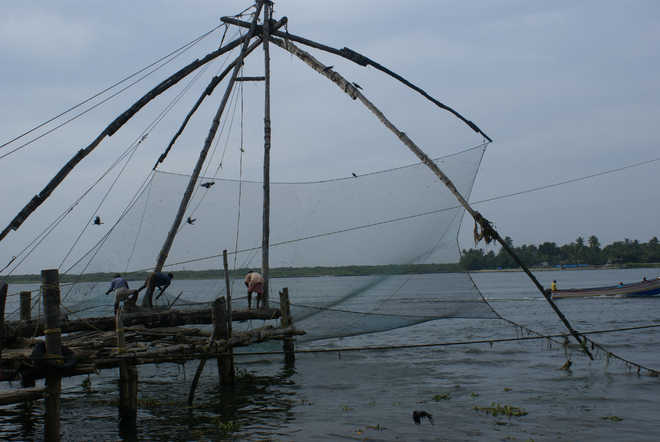
From the Silk Route: Mounted on pivoted, wooden scaffolds, the Chinese fishing nets recall the ancient trade connection Photos by the writers
Hugh and Colleen Gantzer
Fort Cochin in Kochi is as old as colonial history yet the city remains relevant even today. As we walked down its quiet avenues, identifying the historic colonial houses, external stairways led to the airy residences of former Portuguese dwellings with their secure slaves’ quarters below. The Dutch expats’ homes had half doors to exclude animals, let in light and air. The British pretensions came later: mock half-timbered and sequestered mansions behind high walls often dripping with scarlet bougainvillea. All historic houses have changed hands, been frequently renovated, but we could still identify their original features. We had lived in one of these, formerly the residence of a burra sahib, now a hotel carefully preserved by its heritage-conscious new owners, capturing the atmosphere of the Victorian age with sola-topis on a table and a portrait of the Empress of India.
Down another road we were delighted to find that the manorial, strikingly red, Koder Mansion had been converted into the Menora Restaurant serving Jewish-Malayalee dishes drawn from the family recipes of Cochin Jews. The Koders were the leaders of this Sephardic community, exiled from Spain because of their faith. They had been welcomed and protected by the local Hindu rulers and there is still a Jew Street in the commercial sector of Matencherry with their Pardesi Synagogue built in the shadow of the former palace of the Cochin Maharaja. This little place of worship is a gem, floored with blue and white willow-pattern tiles, brought from China and lit by glittering chandeliers. Sadly today, it is difficult to assemble the minimum congregation after many of the community migrated to Israel.
We trudged up the steps of the Maharaja’s Palace, now protected by the Archaeological Survey of India. Its display of royal robes and weapons is interesting and its murals in the lower-level, women’s quarters are appropriately graphic but entrance to this level is often discouraged by the more prudish attendants! The palace is referred to as the Dutch Palace. Though it was a gift of the Portuguese, the ruling family preferred to attribute it to the more liberal Netherlanders.
The original Portuguese Fort no longer exists but their Church of St Francis is still a living shrine, under the ASI. It holds the headstone of the tomb of Vasco da Gama in the floor of its nave. It says much for the skills of Portuguese architects and builders that, in the very humid environment of Kerala, the church has stood sturdy and unaffected for more centuries than the Taj Mahal. That was probably why its architecture could have influenced mission churches all across America. We were fascinated by a copy of the original register of Births, Marriages and Deaths and the gravestones imbedded in the body of the old church. We have just learnt that the open, recreational, grounds beside it have been raised and fenced in. We hope that it is only visually incongruous and will have no environmental consequences.
The road fronting the church led us to the tidal channel with its iconic Chinese fishing nets clear reminders of ancient China-India ties. They are mounted on pivoted, wooden scaffolds, lowered by teams of men when the tide flows, then raised, filled with silver, wriggling, catch: hopefully!
We ambled down a rain-tree shaded avenue, past the buttressed walls of the old warehouse factories of former traders, externally unchanged since the days of the East India Company. Fort Cochin’s residents have carefully preserved its strikingly 19th century ambience, giving it its unique charm. When the creative Dominics took over the channel-fronting Brunton Boatyard, and converted it into an upmarket hotel, they carefully preserved its colonial era character. According to Jose, chairman of the CGH group, they have even discovered a family of bakers who make the traditional Dutch Breudher bread introduced to Cochin by the original spice merchants from Holland. Those burghers have gone but the aromatic Spice Market still exists dominated by canny generations of Gujarati traders. We returned to be enchanted by the Indo-Portuguese Museum reputedly set up by the famed Gulbenkian Foundation.
Coming full circle, from the Portuguese to the present, Fort Cochin’s Biennial now lures international art lovers, retaining its evergreen relevance.



























